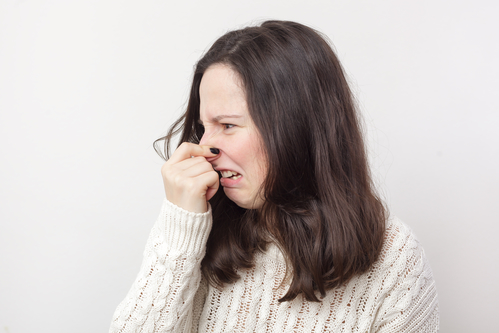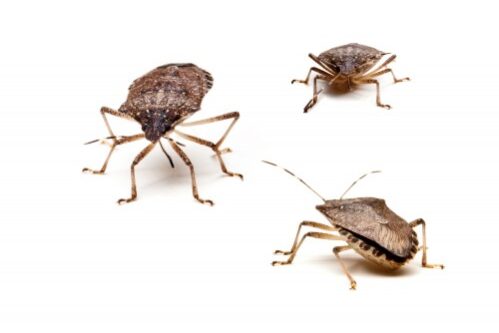Soon, stinkbug season will be upon us. You may have seen them in your house this Spring, but stinkbugs can only be effectively treated (if the goal is to keep them out of your home) in August and September. If you’re wondering when to treat for stinkbugs, the answer is REALLY SOON and making you appointment with us now will insure that you get on our list. Here are some things you should know about the stink bug:
What Are They?
Native to Japan, Korea, Taiwan and China, Halyomorpha halys were accidentally imported to the United States in the late 1990s (first seen in Pennsylvania) and remain a significant pest to agriculture. They have since spread to 33 states, and are heavily noted in the state of Virginia. Sometimes known as “shield bugs” because of their distinctive shape, they’re much more commonly known as “stink bugs.”
See also Stink Bugs
Stink Bug Questions and Answers
Do stink bugs really stink?
Yes, stink bugs really do stink. A tiny gland located on their thorax between the first and second pair of legs emits a liquid toxin with the pungent odor (described by some as similar to that of smelly feet) that is their primary defense. This odor acts as a repellent to birds or any other predator that might threaten the stink bugs—including humans. Stink bugs release their odor when chased, picked up, or stepped on. If you have a lot of them in your house, the smell tends to linger (fortunately it can be eliminated by washing down the surfaces with ordinary soap and water).
Why Are There So Many Stink Bugs?
Stink bugs reproduce 4 times a year. Each time a stink bug reproduces, it lays between 20-30 eggs on tree and other plant leaves. Stink bugs undergo metamorphosis in three stages: egg, nymph and adult. The eggs are laid in groups on stems and the undersides of leaves. When nymphs emerge, they look similar to the adult stink bug, but may appear rounder rather than shield-shaped. Nymphs go through five instars before becoming adults, usually in 4-5 weeks. The adult stink bug overwinters under boards, logs or leaf litter. In some species, the nymphs may also overwinter.
With no natural predators in the United States, multiple reproductive cycles, fast development and an ability to travel easily (hitching rides on buses and in construction materials), the numbers of stink bugs have exploded, and they’re spreading fast across the country.
 What Makes Stink Bugs Such A Nuisance?
What Makes Stink Bugs Such A Nuisance?
While stink bugs are NOT known for biting, stinging, or carrying diseases, they will gobble up your fruits and veggies – and even your ornamental trees and shrubs. What’s even more annoying to urban dwellers is their propensity for moving in: when the weather gets cold, they seek shelter in detached homes and apartment and office buildings alike, sneaking in through cracks, screenless windows and any other openings. And because they’re resistant to most conventional pesticides and small enough to hide almost anywhere, once they’re in, they’re tough to get out.
What Is The “Peak Season” For Stink Bugs?
Because stink bugs won’t reproduce indoors and their food is mostly outdoors, they won’t try to move into until it starts to get cold – usually around late September/early October. The insects sneak in through small cracks and openings in chimneys, door and window frames, air conditioning units, attic vents and holes in a home’s foundation. They hide out in toasty, dark spots during the winter, and emerge from hibernation late in the Spring. That’s when you’ll notice them become active again. If you want to avoid Stink bug infestation in your home or office, the best time to get treatment is PRIOR to cold weather – September is probably the ideal month here in Virginia.
What’s The Best Way To Get Rid Of Stink Bugs?
Part of what makes stink bugs so difficult to control is the fact that they are resistant to many types of pesticides. Holistic Pest Solutions can treat your home or business for Stink bugs utilizing very effective methods. If you only have a few stink bugs here and there, you may be able to handle it on your own. If you find them on your plants, shake them off into a bucket of soapy water – the soapy water keeps them from flying away. If you only find a few stink bugs in your home, vacuuming them up may be the best way to vanquish the little beasts, but be sure to use a vacuum with a bag that you can remove, seal up and discard when you’re done. Flushing them down the toilet when they’re alive works well if you don’t want to smell them at all
Whatever you do, don’t smash them – not only do they smell bad, their distinctive odor attracts others of their kind. In addition to deterring predators, a stink bug’s odor sends a chemical message to other stink bugs, alerting them to danger. The scent glands also play a role in attracting mates, and even suppress attacks by harmful microorganisms.
*Our Environmental Commitment: Holistic Pest Solutions is committed to the preservation of our environment. Our goal is to nurture the soils and plant life of lawns and landscapes. Utilizing holistic pest control practices that cause the least amount of impact on the environment.








